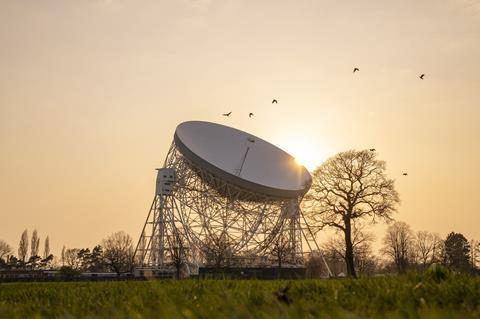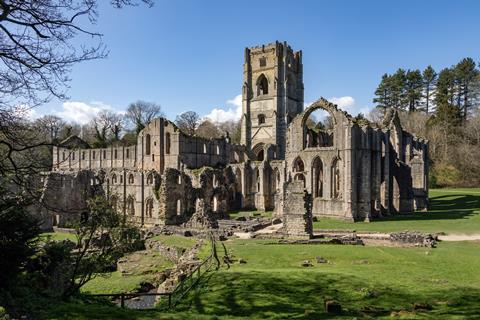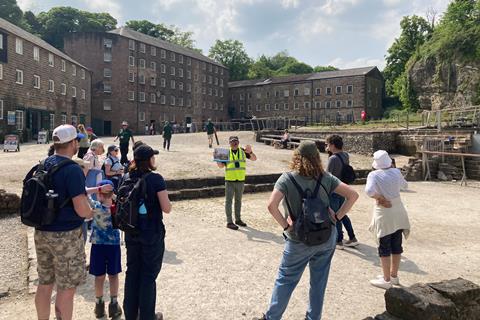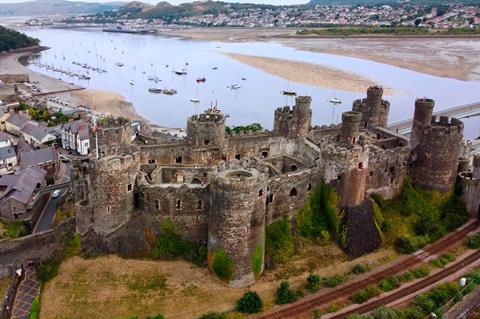If a site has been awarded World Heritage status by UNESCO, it’s got to be special. And these gems have great stories to tell.
1. Ironbridge
The Ironbridge Gorge’s UNESCO World Heritage Site in Shropshire status stems from its contribution to the beginnings of the Industrial Revolution, the greatest symbol of which is the iconic Iron Bridge, the world’s first bridge constructed of iron. A selfie on the bridge is a must for your groups. To dig deeper into its history, groups can visit the original Iron Bridge Tollhouse, too.
While you’re in the Gorge, take your group to one or more of the Ironbridge Gorge Museum Trust’s other museums which tell the history of the area. They include a recreation of a Victorian town, china and tile museums and a museum of iron. Benefits for groups of 15 or more include free coach parking, plus free entry for the group organiser and coach driver.

2. New Lanark Trust
Immerse yourself in the history of New Lanark on a guided tour. Uncover the stories of the millworkers and the innovative ideas that shaped the 18th-century village which has been a UNESCO World Heritage Site since 2001. Expert guides will share fascinating insights into its social and industrial heritage, as well as its meticulous restoration. More than a glimpse into the past, New Lanark is a vibrant, living community which still spins its own yarn onsite.
After your tour, enjoy lunch in the Café, take a peaceful walk along the Falls of Clyde, and discover all that New Lanark has to offer. Groups coming from further afield can factor in a stay at the four-star hotel.

3. Jodrell Bank
The iconic Jodrell Bank site in the heart of the Cheshire countryside has long been a symbol of scientific exploration. At its core stands the Lovell Telescope, a Grade I listed engineering marvel. Its purpose? To unravel the secrets of the sky and stars above. With its 250ft-wide dish, it’s the UK’s largest steerable radio telescope and has been in constant use by astrophysicists from across the globe since 1957.
Groups can also visit the First Light Pavilion where exhibitions reveal the Lovell’s secrets, from tracking Sputnik to Apollo moon missions. Group visits (ten plus) are self-guided and are discounted, with free coach parking and one free admission per group.

4. Blenheim Palace
Groups are encouraged to visit Blenheim Palace during off-peak dates from 6th January to 31st March 2025, to save money on admission and benefit from tailored packages, including guided tours that delve into the history of the UNESCO World Heritage Site.
Explore the State Rooms, beautiful park and gardens, as well as its captivating exhibitions. Groups are welcomed by a member of the team, and catering packages can be arranged from ready-to-go grab bags, to a stunning Afternoon Tea in The Orangery Restaurant. Pre-booking is essential for guided tours.

5. Fountains Abbey
This UNESCO World Heritage Site is a unique place where medieval strength blends with 18th century eccentricity to create a landscape full of secrets, curiosities and breathtaking views.
The ruins of Fountains Abbey near Ripon in North Yorkshire showcase one of the largest and best preserved ruined Cistercian monasteries in England, where you’ll see vaulted ceilings, grand columns and an imposing tower. Nearby, the garden at Studley Royal features elegant ornamental lakes, canals, temples and cascades to explore. Group rates are available.

6. Canterbury Cathedral
Groups visiting the Kent landmark can discover stories that have helped shape England’s history, from the shocking murder of Archbishop Thomas Becket through to tales of the lives of King Henry IV and the Black Prince, both of whose tombs are contained within. Groups of all sizes are welcome, with customisable itineraries from short talks to behind the scenes tours available.
Expert-led guided visits provide an in-depth look at the Canterbury Cathedral’s history and architecture, with a choice of themed guided tours, ranging in subject from the ‘Thomas Becket Story’ to an examination of the cathedral’s historic stained-glass windows. Group catering packages are also available, along with a wealth of other top attractions in the city to combine with your visit.

7. Derwent Valley Mills
Explore the sights and smells of the Derwent Valley Mills World Heritage Site in the Peak District and you can discover more about the birthplace of the modern factory system. At Cromford Mills, groups can enjoy tours, the Richard Arkwright Experience and historic machines illustrating how cotton spinning changed the world.
The new hydropower waterwheel has put waterpower back into the heart of Cromford Mills. At nearby Masson Mills, uncover the huge collection of historic textiles machinery and discover those that industrially revolutionised the processing of raw cotton into spun yarn and raw cotton.

8. City of Bath
Founded by the Romans as a thermal spa, Bath became an important centre of the wool industry in the Middle Ages. In the 18th century, under George III, it developed into an elegant town with neoclassical Palladian buildings, which blend perfectly with the Roman baths.
Highlights for groups in the city not only include its legendary baths and its large Abbey (there are group rates for both), but also its Georgian landmarks like Pulteney Bridge and the Royal Crescent – consisting of 30 Grade I Listed terrace houses forming a 500-foot-long crescent.

9. Castles and Town Walls of King Edward
Those heading to the north of Wales can visit all four of Edward I’s mighty coastal fortresses, which were given UNESCO World Heritage Status in 1986. The four fortresses: Beaumaris, Conwy, Caernarfon and Harlech are the finest examples of late 13th century and early 14th century military architecture in Europe, making them one of the major references of medieval history in the world.
If you’ve only got time for one, pick Harlech for dramatic views, pick Beaumaris if you’re history buffs – it is said to be the greatest castle to never be built as exuberant plans petered its construction due to lack of funds. Plus there is Conwy or Caernarfon for architectural beauty.

10. The Forth Bridge
Did you know that 53,000 tonnes of steel and 6.5 million rivets were used to construct this Scottish landmark?
Spanning the estuary of the River Forth to link Fife to Edinburgh by railway, the iconic bridge was the world’s earliest great multi-span cantilever bridge, and remains one of the longest at more than 2,500 metres.
Groups can hop aboard a boat tour to sail underneath the great bridge, or simply admire it from the banks of the waterway. On a clear day, head up to the top of Edinburgh Castle and you’ll be able to appreciate its size from well over 14 miles away.
For more information about UNESCO World Heritage Sites in the UK, visit whc.unesco.org/en/statesparties/gb.













